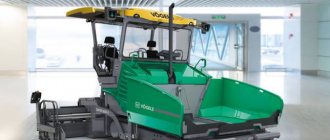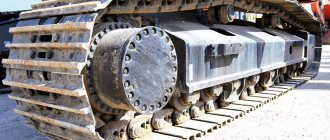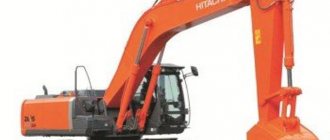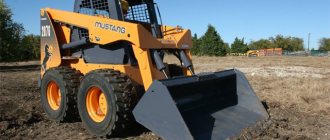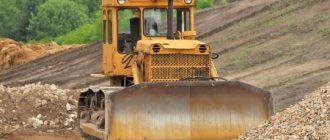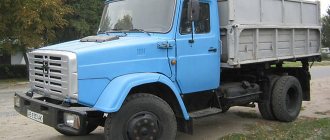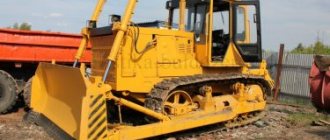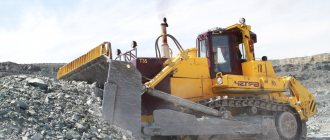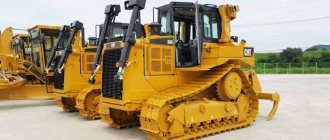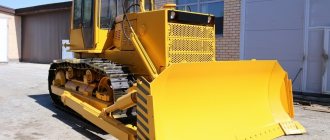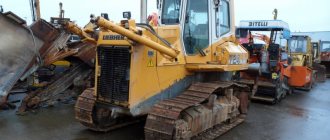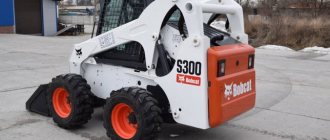Bulldozer DZ-27S based on T-130.1.G-1
1
– push bar;
2
– knife;
3
– blade;
4
– screw brace;
5
– hydraulic cylinder;
6
– tractor
| Loader-bulldozer DZ-133 | |
| Bulldozer-loader DZ-133 1 - bucket; 2 - devices for changing working parts; 3 - boom; 4 — hydraulic cylinders working in pairs; 5 — control of the boom and bucket; 6 — base tractor; 7 — rods; 8 - supporting frame. | Replaceable additional working equipment 1 - enlarged bucket; 2 - snow bucket; 3 - agricultural forks; 4 — cargo forks; 5 — mounting hook; 6 - jaw grip; 7 - extension; 8 — widener and reverse ripper. |
Bulldozer DZ-42G
| 1 - knife; 2 - blade; 3 — visor; 4 — bracket; 5 — lifting-lowering hydraulic cylinder; b - base tractor; 7 — hydraulic distributor control lever; 8 — transverse beam with axles; 9 - push bar. |
Table 1.2 Technical characteristics of bulldozers on tractors of traction classes 3 and 4
Bulldozer DZ-101 A
| 1 - push bar; 2 - blade; 3 - hydraulic brace; 4 — lifting-lowering hydraulic cylinder; 5 — hydraulic cylinder support; b — basic tractor T-4AP2-S1. |
Bulldozers of traction class 10 are produced on the basis of the T-130MG-1 tracked tractors, its modernized model T-170 and its modifications T-170.01, T-170.40 and T-170.41.
| 1 - bulldozer equipment; 2 - g base tractor T-130MG-1 (T-170.01). Bulldozer DZ-110V (DZ-171.1) |
Similar articles:
poznayka.org
DESCRIPTION AND PURPOSE
DZ 27 is a series of bulldozers of the tenth traction class with a fixed blade, the base for which was the T 130 tractor. The equipment is intended for operation in various zones, including the Far North. The series includes several models, differing in scope and individual design elements. In addition to the basic versions (T 130 tractor), consumers were offered variations based on the T 140 and T 170 tractors.
The DZ 27 bulldozer is used to develop and move materials and soil of categories 1-3 over a distance of up to 300 meters. The equipment is used during construction and road work, operations in forestry and agriculture, work in quarries and areas with uneven surfaces. The machine copes well with the development of piles, embankments, reclamation, leveling of construction sites and clearing the area of trees, stones and small structures. Less commonly, a bulldozer is used in mining operations.
The release of DZ 27 ended quite a long time ago. The rights to the series currently belong to (Yaroslavl), which is engaged in the official sale and maintenance of these bulldozers. The machines undergo a full overhaul, receive a passport (YARB-170) and a certificate of conformity. In addition, the equipment after repair is provided with a warranty of 900 operating hours (9 months of operation).
Bulldozers
| #G0 EARTHING AND TRANSPORTING MACHINES (BULLDOZERS, SCRAPERS, GRADERS) BULLDOZERS A bulldozer is an earth-moving and transport machine based on a caterpillar tractor or wheeled tractor with replaceable attachments for layer-by-layer development and movement of soil (Fig. 1). The equipment consists of a blade - a frontal shield with side flaps, a frame and a blade control mechanism. Bulldozers with fixed and rotary blades are used. The fixed blade is mounted permanently perpendicular to the longitudinal axis of the tractor, and the bulldozer can only move soil in front of the blade. For bulldozers of the second type, the blade can be rotated in any direction and installed at an angle of 60° relative to the longitudinal axis of the tractor and tilted by 6... 10° in the vertical plane. Such a bulldozer can move soil to the side and perform rough leveling work, i.e. it has great technological capabilities. In the transport position, the blade is raised, in the working position it is lowered onto the base and when the bulldozer moves, it crashes into the ground. By type of drive, bulldozers come in mechanical, hydraulic and diesel-electric drives. Bulldozers primarily use hydraulic pumping and electrical control systems. According to the type of blade control, bulldozers are divided into cable-controlled and hydraulically controlled. More effective is hydraulic control, which ensures forced deepening of the blade, whereas with rope control it lowers to the ground only under the influence of its own weight. The dump is designed in such a way as to ensure the most efficient development, accumulation of soil into a prism and its movement. As the bulldozer moves, the cut layer of soil accumulates until it reaches the top of the dump. In the transport position, the blade rises to the surface of the soil, cutting off irregularities or filling depressions with soil, and leveling the surface occurs. If the bulldozer fills the embankment layer by layer, then the dump is located at a distance from the base equal to the thickness of the layer being filled. Fig.1. Bulldozer: - pushing frame; 2 — braces; Scope of application of bulldozers: development and movement of soil over a distance of up to 100 m when constructing road and railway embankments from reserves, construction of dams, construction of pits and canals, site planning and finishing of earthworks. In addition to these basic works, the bulldozer can perform numerous preparatory, auxiliary and maintenance work. This includes clearing construction sites, clearing roads and airfields of snow, removing garbage, etc. Bulldozers also work in conjunction with other earth-moving machines, performing, for example, layer-by-layer leveling of soil for compaction when filling embankments with dump trucks. They are also used as scraper pushers when collecting soil. For this purpose, the bulldozer blade is equipped with an additional attachment - a pushing frame. Powerful bulldozers have rippers as attachments, which significantly expands their scope of application, allowing them to be used in dense and frozen soils. Such a wide range of applications for bulldozers has made these machines the most common (along with excavators) in construction. They carry out about 40% of the total volume of earthworks. Depending on the technical and technological characteristics of earthen structures and the types of work performed, bulldozers are subject to various production requirements and machines are used that meet these requirements with power, running equipment, type of drive, the presence of attachments and other technical characteristics (Tables 1, 2). The main parameter of a bulldozer is the traction class or traction force of the base tractor (tractor). Three groups of bulldozers are most widespread in construction: 1) light ones, with a traction force of up to 60 kN; 2) medium, with a traction force of 100...150 kN; 3) heavy, with a traction force of 250 kN and above. Machines of the first group are used mainly as components for auxiliary and household work, and in small-sized versions - in cramped conditions. Machines of the second group are used for basic work when developing soils of the first - third groups (with rippers and denser ones), and heavy bulldozers perform basic work at large sites and in areas with extreme natural conditions. For example, in the group of heavy bulldozers on tractors of traction class 25, the DZ-118 bulldozer with an electromechanical transmission and hydraulic drive is common, which ensures raising and lowering the blade to the required height or depth and changing the cutting angle. The bulldozer is equipped on the basis of an industrial tractor DET-250M with a power of 243 kW. This power allows you to develop soils of any category, including frozen and blasted rocks. Table 1
* Here and further in the tables: without brackets - according to industrial classification, in brackets - according to agricultural classification. ** Pusher bulldozer. *** DZ-110Ach-1 has an automatic control system for the working body - Combiplane YUL. table 2 | |||||||||||||||||||||||||||||||||||||||||||||||||||||||||||||||||||||||||||||||||||||||||||||||||||||||||||||||||||||||||||||||||||||||||||||||||||||||||||||||||||||||||||||||||||||||||||||||||||||||||||||||||||||||||||||||||||||||||||||||||||||||||||||||||||||||||||||||||||||||||||||||||||||||||||||||||||||||||||||||||||||||||||||||||||||||||||||||||||||||||||||||||||||||||||||||||||||||||||||||||||||||||||||||||||||||||||||||||||||||||||||||||||||||||||||||||||||||||||||||||||||||||||||||||||||||||||||||||||||||||||||||||||||||||||||||||||||||||||||||||||||||||||||||||||||||||||||||||||||||||||||
shkolnie.ru
Legislative framework of the Russian Federation
valid Editorial from 06.12.1994
detailed information
| Name of document | “RECOMMENDATIONS FOR LABOR STANDARDS FOR EMPLOYEES OF EXTERNAL IMPROVEMENT ENTERPRISES” (approved by Order of the Ministry of Construction of the Russian Federation dated 06.12.94 N 13) |
| Document type | list, recommendations |
| Receiving authority | Ministry of Construction of the Russian Federation |
| Document Number | 13 |
| Acceptance date | 01.01.1970 |
| Revision date | 06.12.1994 |
| Date of registration with the Ministry of Justice | 01.01.1970 |
| Status | valid |
| Publication |
|
| Navigator | Notes |
“RECOMMENDATIONS FOR LABOR STANDARDS FOR EMPLOYEES OF EXTERNAL IMPROVEMENT ENTERPRISES” (approved by Order of the Ministry of Construction of the Russian Federation dated 06.12.94 N 13)
TECHNICAL CHARACTERISTICS OF THE MACHINES USED
Table
BULLDOZERS AND ROLLERS
| Brand of bulldozer, roller | Indicator name | ||||||||
| blade length, m | dump height, m | control | power, kW (hp) | tractor brand | mass of bulldozer, roller, t | operating speed, km/h | track width, wheels, mm | number of wheels, tracks, pcs. | |
| 1 | 2 | 3 | 4 | 5 | 6 | 7 | 8 | 9 | 10 |
| Bulldozers | |||||||||
| DZ-29 (D-535) | 2,56 | 0,8 | Hydraulic | 56(75) | T-74 | 6,37 | 2,4 | 390 | 2 |
| DZ-42 (D-606) | 2,56 | 0,82 | -« | 56(75) | DT-75 | 6,89 | 3,5 — 4 | 390 | 2 |
| DZ-53 (D-686) | 3,2 | 1,2 | Ropeway | 79(108) | T-100 | 13,23 | 2,4 — 3 | 500 | 2 |
| DZ-54S (D-687S) | 3,2 | 1,2 | Hydraulic | 79(108) | T-100 | 12,88 | 2,4 — 3 | 500 | 2 |
| D-259 | 4,15 | 1,1 | Ropeway | 79(108) | T-100 | 13,37 | 2,4 — 3 | 500 | 2 |
| DZ-27S (D-523S) | 3,2 | 1,3 | Hydraulic | 118(160) | T-130 | 16,91 | 2,4 — 2,8 | 700 | 2 |
| DZ-110 | 3,2 | 1,3 | Hydraulic | 118(160) | T-130 | 16,91 | 2,4 — 2,8 | 700 | 2 |
| DZ-9 (D-275A) | 3,35 | 1,1 | Ropeway | 132(180) | T-180 | 17,28 | 3 — 3,4 | 700 | 2 |
| DZ-35S (D-575S) | 3,64 | 1,29 | Hydraulic | 132(180) | T-180 | 17,75 | 3 — 3,4 | 700 | 2 |
| DZ-24 (D-521) | 3,36 | 1,1 | -« | 132(180) | T-180 | 16,31 | 3 — 3,4 | 700 | 2 |
| DZ-24A (D-521A) | 3,64 | 1,43 | Ropeway | 132(180) | T-180 | 17,21 | 3 — 3,4 | 700 | 2 |
| Ice rink | |||||||||
| KM-305 (KU-701) | 3,4 | 1,4 | Hydraulic | 219(300) | KS - 701 | 23,5 | 3 — 5 | 700 | 4 |
Table
SCRAPERS (TRAVLED)
| Indicator name | Unit | Scraper brand | |
| DZ-30 (D-541A) DZ-33(D-569) | DZ-20(D-498) DZ-20A | ||
| Bucket capacity | cube m | 3 | 7 |
| Working width | m | 1.9 and 2.1 | 2,59 |
| Depth of cut | -« | 0,2 | 0,3 |
| Thickness of the poured layer | -« | 0,3 | 0,35 |
| Power | kW (hp) | 55(75) | 79(108) |
| Scraper weight | T | 2,75 | 7 |
Table
EXCAVATORS WITH MECHANICAL DRIVE
| Indicator name | Excavator brand | |||
| EO-1621 (E-153) | EO-3211 (E-302) | EO-3311G, (E-302G) EO-3111A (EO-303A) | E-504 E-506 | |
| Bucket capacity with teeth, cubic meters. m | 0,15 | 0,3 | 0,4 | 0,5 |
| Boom length, m | 2,3 | 4,9 | 4,9 | 5,5 |
| Largest cutting radius | 4,1 | 7,8 | 7,8 | 9,2 |
| Maximum digging depth: | ||||
| — for trenches, m | 2,2 | 4 | 4 — 4,4 | 5,5 |
| - for pits | 2,2 | 2,6 | 2,6 — 3 | 4 |
| Radius of unloading into transport, m | 2,1 | 4,2 | 4,15 | 5,4 |
| Height of unloading into transport, m | 1,7 | 2,25 | 2,7 — 3 | 1,7 |
| Power, kW (hp) | 27(37) | 28(38) | 37(50) | 59(80) |
Repair of bulldozers DZ 27S (T 130)
Home→Repair of bulldozers DZ 27S (T 130)
Overhaul of DZ 27S bulldozers based on the T-170 (T-130) tractor
OJSC "Stroytekhnika" carries out major repairs of heavy equipment based on tractors of the T-170 (T-130) series. Tractor repair activities are confirmed by certificates, carried out entirely in factory conditions using the latest equipment, highly qualified personnel with many years of experience will replace worn parts with new ones.
After a major overhaul, all tractors undergo inspection of repaired units on special stands during acceptance tests. The technical characteristics of the T-170 tractor, which has undergone replacement of some components, are completely identical to the technical characteristics
new T-170.
List of activities for a tractor of any category:
For the T 130 tractor, repairs include a certain list of activities, in particular, troubleshooting the base machine, disassembly, priming, putty, bench testing, final assembly and painting.
Time frame for major overhaul of T-170 (T-130):
According to the timing, major repairs are carried out within 20 working days from the date of delivery for repairs. The duration of the T 130 repair depends on several factors: the level of production capacity utilization, the category of major repairs and payment terms.
Price:
The cost of a major overhaul of the T-170 tractor is 50%-85% of the cost of a new unit. The specific price depends on the configuration and operating condition of the chassis system, as well as the complexity of the repair. You can find out about repair prices by calling.
Terms of payment:
For the T 130 tractor, repairs and terms of payment are discussed in advance. The timing of the order and the cost of repairing the T-170 tractor are determined depending on the degree of defectiveness and the wishes of the customer. Additionally, the T-170 tractor can be equipped with bulldozer units, a ripper, a clamp and other specialized machines.
www.yarst.ru
Modifications and features
The DZ 27 bulldozer represented traction class 10 and had several modifications. The main model was produced on the basis of the T 130 tractor, but variations were also available, which were based on the T 140 and T 170 tractors. Differences also manifested themselves in the type of blade used, climatic design and individual characteristics. At the same time, the bulldozers were similar in most elements.
Features of the DZ 27 model:
- versatility and unpretentiousness. The bulldozer can be used to perform a wide range of operations in the most difficult conditions;
- powerful and reliable engine providing excellent traction characteristics;
- spacious cabin with a high level of comfort;
- high cross-country ability. The equipment works effectively on uneven ground;
- simplicity of design and maintainability. You can repair the car yourself, and the cost of spare parts always remains low.
The sale of DZ 27 bulldozers after major repairs is carried out by the Yaroslavl enterprise Stroytekhnika, which carries out pre-sale preparation and additionally offers the following options:
- Spare parts, fire extinguisher, first aid kit;
- hydraulic brace;
- chassis protection;
- transmission protection;
- engine pre-heater;
- hood insulation;
- oil-air heater.
One can only envy the performance of D 28 bulldozers
Bulldozer DZ 28 is a true classic of domestic mechanical engineering. Produced in the USSR on the basis of the T-130 tractor, it may seem outdated only at first glance. Although about 50 years have passed since the release of this model, the design and basic elements of bulldozer equipment have not changed that much. If you do not take into account the level of comfort and computerization, in terms of reliability and performance protection the 28 is in no way inferior to modern analogues, and in terms of price and cost of spare parts it even surpasses them.
The DZ 28 bulldozer, like the base tractor T-130.1G-1, according to the generally accepted classification, belongs to the 6th (medium) traction class of general purpose bulldozers, since it is equally suitable for land development, transportation and auxiliary activities, regardless of the type of soil. (first, second or third category) have to work. However, the use of DZ 28 in harsh climatic conditions is not justified. It is more suitable for regions with temperate climates.
Technical characteristics of the D 28 bulldozer based on the T-130 tractor
Let's look at the main technical characteristics of the DZ 28 bulldozer. Of course, today hardly anyone can be surprised by the standard 13.53 liter diesel engine "D-160" for tractors of the second half of the 20th century, which has a turbocharger, 4 cylinders, an electric starter and a pre-heater (for starting in the cold). The power of the DZ 28 engine is not very high - only 160 hp. at 1250 rpm. However, scientific and technological progress makes it possible to easily overcome this disadvantage in most obsolete models of bulldozers, including DZ 28, by installing more modern engines, for example, produced by Yaroslavl Motor, DEUTZ AG.
The main and very fundamental difference between the DZ 28 bulldozer and other modifications of the T-130 tractor is that it is equipped with a straight rotary blade. The frame is mounted on hinges to the tractor body, a blade ball support is welded to it, and pushers are installed on the sides. The bulldozer operator manually moves the pushers and thereby moves the blade left, center or right. Bulldozers with rotary blades are more often used in road work, for example, to clear the roadway of snow. Thus, the presence of a rotary blade expands the scope of application of the DZ 28.
The length of the DZ 28 blade is 3.94 m, and the height is 1 m. The weight of the attached bulldozer equipment is 2 tons. The total mass of the DZ 28 bulldozer together with the blade, frame and ball joint is 14.9 tons. The lowest point of the blade location is 44 cm from the supporting surface. The upper one, also in relation to the supporting surface, is 105 cm. The maximum cutting angle of DZ 28 knives is 60 degrees. The angles of transverse warp and plan warp are 5 degrees, respectively. and 63-90 degrees. The blade, skew angles, and direction of rotation are controlled manually using a cable-pulley system.
The DZ 28 bulldozer is equipped with a load lifter with 2 hydraulic pumps and a friction winch type NSh-98U. Executive hydraulic pumps provide a pressure of 10 MPa. Gearbox (8 speeds x 4 shafts) – mechanical type with a double-disc closed clutch. Gearbox gears are constant mesh. The speed of the bulldozer in transport position is 8.8-12.25 km/h. The working speed of the bulldozer depends on the type of work performed. For example, when cutting soil and moving it further, the average speed is 3.5 km/h, when moving back in reverse gear – from 4.9 km/h. up to 9.9 km/h, in forward gear – from 4.4 km/h. up to 8.8 km/h.
Optional capabilities and features of the chassis of the bulldozer D 28
Tractors of the T-130 type are not equipped with a power take-off shaft, although this is technically possible, so power is taken off from the crankshaft (front) and from the upper gearbox shaft (rear).
The basis of the bulldozer chassis is a caterpillar track with 5 support and 2 support rollers on each side. The width of the track shoes is 50 cm. The bulldozer undercarriage is equipped with a balancing plate suspension. The ground clearance is 40.7 cm. The track width is 1.88 m. The bulldozer cabin is designed for two people, noise and heat insulated. Ventilation is carried out using a supply valve, and there is a heating system. If necessary, it is possible to install air conditioning and reinforced double-glazed windows.
The list of options with which you can expand the functionality of the DZ 28 bulldozer is certainly huge. However, with all the possibilities, such a radical modernization of equipment is not always necessary. The advantage of DZ 28, first of all, is its many years of “experience” in use, ease of maintenance and low cost, which can only suffer when trying to improve it.
promplace.ru
History of creation
The invention of the caterpillar track is as great and fundamental as the invention of the wheel. But if the creator of the wheel is unknown, then the tracks were invented by the Russian peasant Fyodor Abramovich Blinov, born in 1827 in the village. Nikolskoye, belonging to the Volsky district of the Saratov province. The inventor's parents were serfs.
In 1926, the Supreme Council of the National Economy of the Soviet Union adopted a resolution on the construction of a tractor plant in Stalingrad. The foundation of the Stalingrad, and subsequently the Volgograd Tractor Plant (VgTZ) took place on 07/12/1926, and already on 06/17/1930 the first STZ-1 was produced - a wheeled tractor with a 30 hp engine. By 1932, more than 140 tractors a day were already rolling off the plant’s assembly line.
The basic model of the DZ-42 bulldozer is the DT-75 tracked tractor, the production of which began in 1963. Unlike its predecessor, the DZ-42 performed any excavation work and was used in the formation of construction sites. The versatility of the bulldozer was ensured by the fact that a universal blade was installed on it, on which it was possible to change the angle of inclination.
Currently, VgTZ is a tractor company that is part of the Tractor Plants concern. During the existence of production, the company has produced a number of modifications of the DZ-42, the demand for which remains at a high level.
For example, at the Soviet research drifting station “North Pole-30”, opened on 10/09/1987 and existed until 04/04/1991, the DT-75 swamp rover and the DZ-42 bulldozer worked as transport.
Start of operation
Before leaving for work, the driver-machinist inspects the DZ-42 bulldozer and eliminates any malfunctions discovered during the inspection. The inspection is carried out with the engine turned off.
Operation of a bulldozer that is in a faulty condition is strictly prohibited.
Only trained and licensed drivers are allowed to work on the DZ-42. It is necessary to check whether the lighting installed on the bulldozer provides sufficient visibility of the entire surrounding work area. Do not leave a running machine unattended, and do not carry out adjustment or lubrication work while moving. You can begin maintenance and repair of the bulldozer only after the engine is completely stopped.
During operation, the driver-driver deepens the blade into the ground by 410 mm at an angle of 55° and directs the movement of the bulldozer in the desired direction. In this case, the required layer of soil is cut off with knives and at the same time moved to the place designated for unloading. This process is called backfilling, after which the dump must be raised and then the cycle repeated again. The soil moves a distance of no more than 60 m.
Engine
The DZ 27 bulldozer is equipped with a 4-stroke D-160 diesel engine with liquid cooling and turbocharging. The power plant is started from the driver's seat using an electric starter (at sub-zero temperatures, the pre-heater makes starting the engine easier). Mixture formation and combustion of fuel occurs in a chamber at the bottom of the piston.
The main component that takes the greatest loads is the cast iron cylinder block. The walls and vertical partitions of the block serve as supports for the crankshaft, camshaft and decompressor roller. At the bottom of the block there is a crankcase with 2 drain holes blocked by plugs. The engine has a common cylinder head for 2 cylinders.
To minimize vibrations that occur during operation, a balancing mechanism is used. The decompression mechanism is used to force the opening of the intake valves. The power system includes a 2-stage air cleaner, intake and exhaust manifolds, a turbocharger and a muffler with exhaust. The power plant uses a combined lubrication system (splash and pressure).
Characteristics of the D-160 unit:
- working volume – 13.53 l;
- rated power - 117.7 (160) kW (hp);
- rated speed – 1250 rpm;
- number of cylinders – 4 (in-line arrangement);
- cylinder diameter – 145 mm;
- compression ratio – 14;
The fuel tank capacity is 290 liters. Specific fuel consumption at average load is 239 (176) g/kW per hour (g/hp per hour).
Specifications
Dimensions:
- length – 4393 mm;
- width – 2475 mm;
- height – 3130 mm;
- wheelbase – 2473 mm;
- ground clearance - 407 mm;
- front track – 1880 mm;
- rear track – 1880 mm.
The total weight of the equipment is 13350 kg, the nominal traction force is 94 kN.
Bulldozer moving speed:
- transport – 8.8-12.25 km/h;
- cutting or moving soil – 3.6 km/h;
- forward return movement – 4.9-9.9 km/h;
- reverse movement back - 4.4-8.8 km/h.
Characteristics of working equipment (blade):
- length – 3200 kg;
- height – 1100 mm;
- maximum lifting height – 800 mm;
- maximum cutting depth – 335 mm;
- cutting angle – 55 degrees;
- weight – 1850 kg.
Transmission and hydraulics
The DZ-42 bulldozer is equipped with a seven-speed manual gearbox (Gearbox), located at the rear axle. A dry, permanently closed double-disc clutch is used to drive the vehicle. The DZ-42 is equipped with band brakes.
To reduce the loads created when turning the bulldozer, the rear axle is equipped with two planetary gearboxes.
The built-in hydraulic system, consisting of a hydraulic power cylinder, hydraulic pump, hydraulic distributor with hydraulic lock and hydraulic safety valve, controls the attachments. Oil is supplied to the hydraulic system through the oil tank and filter.
Operating experience, advantages and disadvantages
A long period of operation has shown the reliability of the DZ-42 bulldozer and its modifications, without revealing any significant shortcomings, which can only include a decrease in speed, compared to the DT-75 prototype, due to the blade canopy.
This is a powerful and productive technique. Even low speed does not prevent you from adapting to a changing work environment. The bulldozer is subject to constant high loads, which are supported due to its robust design. The safety margin of the DZ-42 allows its operation to continue even after the end of the established regulatory period, which requires timely maintenance. The unification of most components and parts makes it possible to quickly replace them.
DZ-42 copes well with digging ditches, ditches and trenches, cutting water drainage channels, constructing embankments and filling holes. With the help of this bulldozer, areas and storage areas are planned for development, embankments and ledges on slopes are constructed, and excavated soil is moved. Additionally, the DZ-42 can be equipped with equipment for loosening hard soil.
Modifications
In addition to the basic model DZ-42, used in construction, public utilities and agriculture, there are three more main modifications that should be considered in more detail.
- DZ-42G is a model specially designed for agriculture, used mainly for reclamation work, as well as in mountainous areas. This bulldozer is equipped with one double-sided hydraulic cylinder.
- DZ-42T - used in swampy and difficult to pass places. This modification was even called “peat”. Due to the width of the tracks, the bulldozer has a noticeably increased supporting area, and the high ground clearance (37 cm) allows it to overcome rubble, ruts and other obstacles. The track links are equipped with lugs, which allows the DZ-42T to work on moving ground in wetlands without falling into unstable ground or peat bogs.
- DZ-42P - the model is equipped with a full-rotating blade, fixed with hinges on push bars mounted on a special transverse beam. When the blade is skewed, the beams rotate due to the hinges and the bulldozer remains in working condition. At the same time, changing the angle of inclination relative to the horizontal plane is very convenient when carrying out work on clearing streets of snow.
